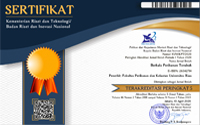Characteristics of Kappaphycus alvarezii carrageenan from different cultivation locations
Abstract
Keywords
Full Text:
PDFReferences
Association of Official Agricultural Chemists (AOAC). 2005. Official Methods of Analysis. Association of Official Analytical Chemists. Benjamin Franklin Station, Washington.
Ega. L., C. G. C. Lopulalan., & F. Meiyasa. (2016). Kajian Mutu Karaginan Rumput Laut Eucheuma cottonii Berdasarkan Sifat Fisiko- Kimia pada Tingkat Konsentrasi Kalium Hidroksida (KOH) yang Berbeda. Jurnal Aplikasi Teknologi Pangan. 5 (2) : 38–44.
Glicksman, M. (1983). Food Hydrocolloids. CRS Press. Inc. Florida. Volume II : 74-83
FOA (2018). The global Status of Seaweed Production, Trade and Utilization. FOA Fisheries and aquaculture Department. Rome.
Food Machinery Corporation FMC Corp. 1977. Carrageenan. Marine Colloid Monograph Number One. Springfield, New Jersey. USA Marine Colloids Division FMC Corporation. p. 23-29.
Hall, S.R. (2009). Biotemplating (Complex Structures From Natural Materials). Singapore: Imperial College Press. Hal 65-66.
Harun, M., Roike,I., Montolalu., & I. Kentut Suwetja. (2013). Karakteristik Fisik Kimia Karaginan Rumput Laut Jenis Kappaphycus alvarezii. Jurnal Media Teknologi Hasil Perikanan Universitas Sam Ratulangi.
Imeson, A. (2010). Food Stabilisers,Thickeners and Gelling Agents. Inggris: Blackwell Publishing.
Kordi, K. M. G. H. (2010). Kiat Sukses Budidaya Rumput Laut di Laut dan di Tambak. Penerbit Andi. Yogyakarta.
Moirano AL. (1977). Sulphated seaweed polysaccharides in food colloids, Graham MD (editor), The AVI Publishing Company Inc, Westpoint Connecticut.
Murdinah. (2008). Pengaruh bahan pengekstrak dan penjendal terhadap mutu karaginan dari rumput laut Eucheuma cottonii. Prosiding Seminar Nasional Tahuan V Tahun 2008 Jilid 3
Pereira, L., & Ribeiro-Claro, P.J.A. (2015). Analysis by vibrational spectroscopy of seaweed with potential use in food, pharmaceutical and cosmetic. In Marine Algae—Biodiversity, Taxonomy, Environmental Assessment and Biotechnology. CRC Press: Boca Raton, FL, USA, pp. 225–247.
Pereira, L. (2018). Review Seaweeds as Source of Bioactive Substances and Skin Care Therapy—Cosmeceuticals, Algotheraphy, and Thalassotherapy. Marine and Environmental Sciences Centre (MARE), Department of Life Sciences, Faculty of Sciences and Technology, University of Coimbra, Portugal.
Rizal, M., Mappiratu, & A. R. Razak. (2016). Optimalisasi Produksi Semi Refined Carrageenan (SRC) dari Rumput Laut (Eucheuma cottonii). Jurnal Kovalen. 2 (1) : 33–38
Takamatsu, S., & Tosa T (1993): Production of L-alanine and D-aspartic acid. Bioprocess Technology 16, 25–35.
Winarno. 1996. Teknologi Pengolahan Rumput Laut. Edisi I. Pustaka Sinar.
Van de Velde F., Lourenco, N.D., Pinheiro, H.M., & Bakkerd. M. (2002): Carrageenan: a food-grade and biocompatible support for immobilisation techniques. Advanced Synthesis and Catalysis 344, 815–35.
Zacharopoulos, V.R., & Phillips, D.M. (1997): Vaginal formulations of carrageenan protect mice from herpes simplex virus infection. Clinical and Diagnostic Laboratory Immunology 4, 465–468.
DOI: http://dx.doi.org/10.31258/terubuk.49.2.902-908
Refbacks
- There are currently no refbacks.
Copyright (c) 2021 Irman Irawan

This work is licensed under a Creative Commons Attribution 4.0 International License.












